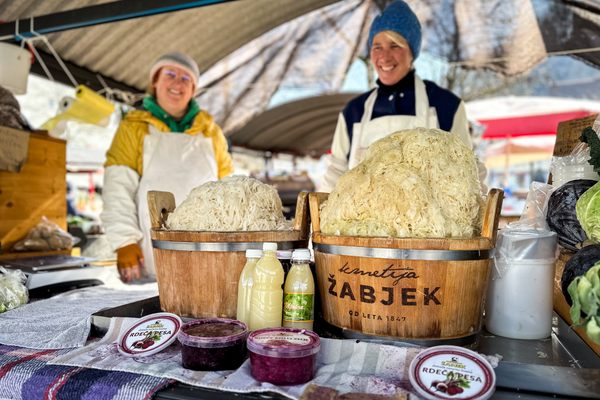How to Cook a Delicious Meal With Zombie Fungus
Conquer your “Last of Us” fears by consuming Cordyceps.
At any given moment, from the rainforests in South America to Tibetan plateaus to Arkansas, the many powder-like spores of the orange-tendriled Cordyceps mushroom may be ready for their zombie-like attack, drifting silently into the air like dust and onto nearby insects. Within days, the fungus floods its new host’s brain with biochemicals, compelling it to walk to the best location for the fungus to grow—effectively turning the insect into a living incubation chamber. After taking over the insect’s body, the fungus shoots through its head, from which it sends new spores to infect more hosts, sometimes wiping out near-whole colonies within months.
I’m always up for a culinary adventure, and so when I learned this fungus really exists, my first thoughts was, of course: Can I eat it? And it turns out that, dear reader, not only can you eat zombie fungus, it is absolutely delicious.
If you’ve played the videogame or watched the recent dramatization of The Last of Us, you may have noticed that Cordyceps, or “zombie fungus,” is having a moment. Cordyceps is a genus, and its approximate 750 identified species across the world have been consuming a range of caterpillars, flies, ants, and other insects for around 48 million years—but humans have likewise found ways to devour these ruthless mushrooms.


The most popular form of Cordyceps in documented use is often called “Caterpillar Fungus,” and grows only on Ghost Moth caterpillars at certain elevations in the Tibetan Plateau, making it one of the most costly and difficult to harvest crops in the world. For centuries, various types of Caterpillar Fungi (the most popular were recently reclassified as Ophiocordyceps sinensis, which is very closely related to Cordyceps) have been used in traditional medicine in China, Nepal, Bhutan, and Tibet, mainly as a tincture and herbal supplement after the fungus has been dried.
While there don’t seem to be copious references to culinary uses of Cordyceps across history, Cordyceps militaris is popularly eaten in Cantonese cuisine. Chefs and home cooks buy it dried and sometimes add it to soups—ranging from pork-based to chicken-and-egg varieties—or stir fry dishes for flavor and an immunity boost.* Some modern-day hobbyist foragers, including those in the U.S., have also been known to collect the fungus and eat it fresh or cooked. (Forage with caution: it may be that not all Cordyceps are edible.)
But for those looking to incorporate the mushroom into a meal, there’s no need to forage: A group of independent mycologists and citizen scientists are now leading the newest cohort of mushroom enthusiasts into the use of Cordyceps militaris as both a medicine and dinner. While this species of Cordyceps will infect caterpillars, it doesn’t need to in order to reproduce fruiting bodies, which is the above-ground part of mushrooms that humans commonly eat. And it’s this ability that led mycologists to begin tinkering with growing the fungus in Cordyceps farm-laboratories.

“I taught myself how to do this during [the first year of] the pandemic. That was my weird tunnel vision project, everyone had one,” says mushroom farmer, cultivator, and workshop teacher Val Ray King of Philadelphia. King grows Cordyceps (sans insects) along with other mushrooms in their laboratories via their business, Impending Doom Relief. They initially found out about Cordyceps cultivation via a workshop by self-taught mycologist William Padilla-Brown in 2019, but developed a special interest in the fungus after feeling some relief of symptoms they experienced with chronic Lyme Disease, which King contracted as a child. Cordyceps are often initially grown from spores bought from a supplier, mainly because they are harder to grow than other mushrooms, says King; it’s more difficult to breed the correct spores needed for successful growth and reproduction in a typical smaller mushroom-farming lab.
When you buy Cordyceps mushrooms, they will often come dried or dehydrated, which King says is a great way to store them; they will keep for about a year, and you can prolong this by freezing. When I opened my packet of dried Cordyceps, it smelled almost nutty and grain-y at once, not too unlike freshly popped kernels of unseasoned, natural popcorn. They’re a vibrant orange, and shriveled in texture, so the first step in cooking is to rehydrate the Cordyceps in cool or warm water until plump. When crisped in butter—King’s favorite way to add them to meals—they taste almost like fried onions, and it was deeply difficult for me not to eat them by the handful. King describes the flavor as a sort of “sweet umami.”
“I’ve been selling [Cordyceps militaris] at markets and people are like, ‘Oh, but isn’t that gonna infect my brain and turn me into a zombie mushroom?’ And I’m like, ‘no, but your hesitation is valid,’” King laughs. “Interestingly, The Last of Us has really shifted [the public’s ideas and awareness about Cordyceps] a little bit, which is funny because it’s actually about a zombie apocalypse, but it’s pure science fiction.”

Scientists aren’t yet sure exactly how the many chemical interactions between Cordyceps fungi and their hosts amount to mind control, but they are relatively confident that humans won’t have to worry about a Cordyceps apocalypse event any time soon.
While Cordyceps fungi have evolved in the past to adapt to changing climates by sending insect hosts to new forest locations, the leap between species would be big. “Insect cells or tissues have very different structural materials than those that form our bodies,” Priscila Chaverri, associate professor of mycology in the department of Natural Sciences at Bowie State University, told me via email. “The immune systems in insects are also very different than in humans.” Evolution takes many iterations across vast amounts of time, Chaverri added, so “for Cordyceps to mutate, evolve, and start killing massive amounts of humans could probably take many millions of years.”
This means, to my delight, that we are all free to consume the delicious fungus as much as we desire. Besides its apparent health benefits and flavor, Chaverri (who is keen to try eating Cordyceps herself) added that “we also have to know that they play a very important ecological role! Without Cordyceps, we would be infested by all kinds of insects. They maintain a balance of insect populations in natural forests.”

King takes that sentiment a step further, which is often central to their workshops and work: While the Cordyceps life cycle might seem scary, our own growing and eating of the mushrooms is itself a participation in a web of ecological relationships. “Interspecies intimacies are all around us, and we see ourselves [humans] at the center of the narrative…and that is so untrue,” says King. Instead of focusing on nature as a series of resource competitions, we can instead think of the roles humans, Cordyceps, and other organisms play–for example, how insect bodies nourish and feed new Cordyceps and other fungal life, as Cordyceps can in turn do for us. “It’s a kind of [mindset that] kind of upends this whole ‘eat or be eaten’ human way of thinking about the world,” says King.
I got the sense that King wants everyone to give Cordyceps a try–despite the fear ingrained by their association with zombies. King shared their own recipes, including a rich bowl of ramen for two and a simple tea, so the rest of the world can cook with Cordyceps as well.
* Update, 3/15/23: This article has been updated to include some popular uses of Cordyceps in Chinese cuisine.
Cordyceps Tea
Val King
Ingredients
- Approximately 1 tablespoon of Cordyceps, dried (add more to your taste)
- 2 cups boiling water
Instructions
-
In a cup, pour boiling water over the Cordyceps, which will float to the top.
-
Steep until the water turns a rich yellow and the Cordyceps sink to the bottom.
- If necessary, steep again with more boiling water until reaching desired flavor.
Val Ray King’s Miso & Cordyceps Ramen
Ingredients
- 1 ounce Cordyceps mushrooms (fresh or dehydrated)
- 2 eggs
- ½ pound fresh ramen noodles
- 4 ounces baby bok choy
- 2 cloves garlic
- 2 scallions
- 1 carrot
- 1 lime
- 3 tablespoons roasted peanuts
- 1-inch piece of ginger
- 1 tablespoon hoisin sauce
- 1 tablespoon sesame oil
- 3 tablespoons canola oil
- ¼ cup sweet white miso paste
- Salt and pepper to taste
Instructions
-
Prep the ingredients: Peel and finely chop the garlic and ginger. Cut off and discard the root end of the scallions; thinly slice, separating the white bottoms and green tops. Peel the carrot and slice into thin rounds, trim off the root ends of the baby bok choy, cut the lime in half lengthwise, and roughly chop the peanuts.
-
Rehydrate the mushrooms, if necessary: If you have dehydrated Cordyceps mushrooms, place them in a small bowl. Pour 8 ounces of boiled water over them and allow them to soak until they are soft and tender. Strain the mushrooms when tender and save the strained water (to add to your broth).
-
Cook and peel the eggs: Gently add eggs to a pot of boiling water. Cook for exactly 7 minutes. Drain thoroughly and rinse under cold water for 1 minute. When cool enough to handle, peel the eggs. Set aside.
-
Cook the mushrooms: In a small pan, heat 1 of the tablespoons of canola oil on high. When hot, add the Cordyceps mushrooms. Sautee on high for 2 to 3 minutes, then reduce the heat to low. The mushrooms will turn from a bright orange to a much darker orange as they cook. Keep them cooking on low until all other steps are completed or until they are completely crisped.
-
Cook the aromatics: In a large pot, heat the remaining 2 tablespoons of canola oil on high. When hot, add the garlic, ginger, and white bottoms of the scallions; add the salt and pepper. Cook on high for 1 minute, stirring constantly. Add the carrot. Continue to cook on high for an additional 2 minutes, continuing to stir. Reduce heat to medium-low.
-
Start the soup: Add 5 cups of water (or if you saved the water from rehydrating your mushrooms, sub out one of the cups of water with that), the miso paste, and hoisin sauce to the pot. Heat to boiling on high. Once boiling, reduce heat to medium and cook, stirring occasionally, for 8 to10 minutes. Add the bok choy and season with salt and pepper. Keep on medium heat and cook until the bok choy stems have softened and the leaves have wilted.
-
Finish the soup: Add the noodles, sesame oil, and the juice of both lime halves to the pot. Cook, stirring occasionally, until thoroughly combined and heated through. Remove from the heat, then add salt and pepper to taste.
- Plate your dish: Divide the finished soup between two bowls. Halve the peeled eggs lengthwise. Top the soup with the crisped Cordyceps mushrooms and the halved eggs. Garnish with peanuts and the green tops of the scallions. Enjoy!
Gastro Obscura covers the world’s most wondrous food and drink.
Sign up for our regular newsletter.

























Follow us on Twitter to get the latest on the world's hidden wonders.
Like us on Facebook to get the latest on the world's hidden wonders.
Follow us on Twitter Like us on Facebook